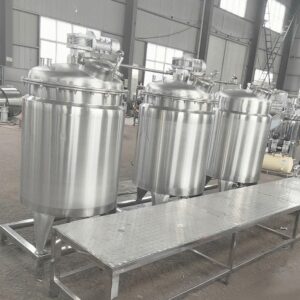An insulated storage tank is a specialized container designed to store liquids at a controlled temperature for extended periods. The tank is equipped with thermal insulation to minimize heat transfer between the stored liquid and the external environment. This feature is crucial for maintaining the desired temperature of the liquid, whether it needs to be kept hot or cold. Insulated storage tanks are widely used in various industries, including food and beverage, pharmaceuticals, chemicals, and energy.
Key Features and Components
1. Thermal Insulation: The tank is wrapped with high-quality insulation materials such as polyurethane foam, fiberglass, or mineral wool, which significantly reduce heat exchange and maintain the liquid at a stable temperature.
2. Stainless Steel Construction: Typically made from high-grade stainless steel (SS304 or SS316) for durability, corrosion resistance, and compliance with hygiene standards, particularly important in food and pharmaceutical applications.
3. Double-Walled Design: Many insulated tanks feature a double-walled construction, where the space between the walls is filled with insulation material, providing an additional layer of thermal protection.
4. Temperature Control System: Some tanks come equipped with integrated heating or cooling systems, such as electric heaters or refrigeration units, to further assist in maintaining the desired temperature.
5. Vent and Pressure Relief Valves: Ensure safe operation by allowing excess pressure to escape and preventing vacuum conditions within the tank.
6. Manhole and Access Ports: Provide access for cleaning, inspection, and maintenance, ensuring the tank remains in optimal condition.
7. Level Indicators and Sensors: Allow operators to monitor the liquid level and temperature inside the tank, ensuring precise control over storage conditions.
8. Foundation and Mounting: Designed for stability and ease of installation, with options for mounted legs, saddles, or skirt supports.
Applications
– Food and Beverage Industry: Storing dairy products, juices, wines, oils, and other temperature-sensitive ingredients.
– Pharmaceuticals: Maintaining the stability of liquid medications, vaccines, and other biotech products.
– Chemicals: Storing chemicals that require temperature regulation to remain stable and effective.
– Energy: Storing thermal fluids used in heating or cooling processes, including solar thermal energy storage.
Benefits
1. Temperature Stability: Maintains the desired temperature of the stored liquid, preventing spoilage, degradation, or loss of efficacy.
2. Energy Efficiency: Reduces the need for constant heating or cooling, saving energy and operational costs.
3. Versatility: Suitable for a wide range of liquids across various industries, from food products to chemicals.
4. Durability and Hygiene: Stainless steel construction ensures longevity, ease of cleaning, and adherence to hygiene standards.
5. Safety: Equipped with safety features such as pressure relief valves and level indicators to ensure safe operation.
Technical Specifications
– Capacity: Available in various sizes, typically ranging from 100 liters to several thousand liters, depending on the application needs.
– Insulation Material: Commonly used materials include polyurethane foam, fiberglass, and mineral wool, chosen based on the required thermal efficiency.
– Temperature Range: Capable of maintaining temperatures from -50°C to 200°C, depending on the insulation and temperature control systems.
– Material: High-grade stainless steel (SS304 or SS316) for the inner tank, with outer layers designed for additional insulation and protection.
– Pressure Rating: Designed to withstand various pressures, with options for atmospheric pressure to high-pressure applications.
Usage Instructions
1. Installation: Ensure the tank is installed on a stable foundation, with all utility connections (power, heating/cooling lines) properly connected.
2. Preparation: Clean the tank thoroughly before use to remove any contaminants.
3. Filling: Fill the tank with the liquid to be stored, ensuring it does not exceed the tank’s capacity.
4. Temperature Control: Set the desired temperature using the control system, if equipped, and monitor the temperature and level sensors regularly.
5. Maintenance: Perform routine inspections and maintenance, including cleaning and checking the insulation, to ensure the tank remains in optimal condition.
6. Safety Checks: Regularly check the vent and pressure relief valves to ensure they are functioning correctly and maintain safe operating conditions.
Conclusion
An insulated storage tank is an essential piece of equipment for industries that require precise temperature control for storing liquids. Its robust construction, advanced insulation, and integrated temperature management systems make it ideal for a wide range of applications, from food and beverage to pharmaceuticals and chemicals. By maintaining stable temperatures, these tanks ensure product quality, safety, and efficiency, making them a valuable asset in any temperature-sensitive storage operation.





Reviews
There are no reviews yet.